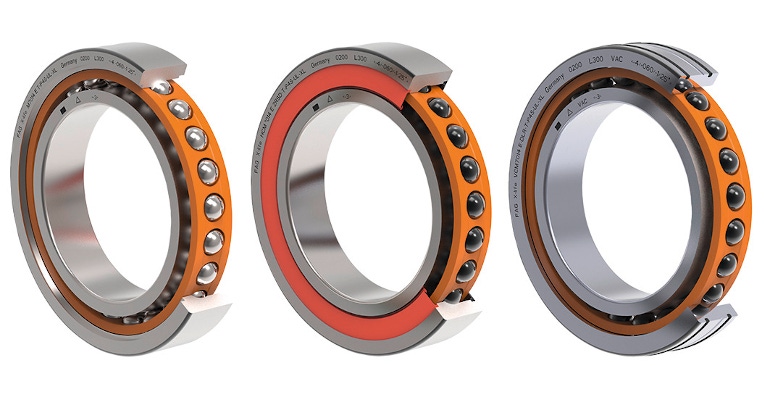How to Build a Better Machine Spindle
A new high-performance rolling bearing steel helped a machine tool maker design motor spindles with a longer operating life compared with that of conventional spindles.
July 13, 2022

Spindles support rotating elements in a wide range of machinery. In metal-cutting machine tools, for instance, spindle bearings provide system stability to ensure surface quality and precision of the workpieces being machined. Such bearings must be highly rigid and durable to be able to accommodate mechanical loads, and they also must exhibit low levels of friction and a high thermal tolerance to enable high speeds.
Global automotive and industrial supplier Schaeffler recently helped a leading machine tool manufacturer double the length of the warranty on its motor spindles, including offering unlimited spindle hours during the warranty period, by utilizing high-speed spindle bearings made from Vacrodur, a new high-performance rolling bearing steel developed by Schaeffler. The global machine tool maker was able to design motor spindles that demonstrate extreme reliability and a considerably longer operating life compared with conventional spindles, particularly under difficult operating conditions.
Schaeffler provided Design News with information on this use case, and we asked E.R. Muntz, senior application engineer for industrial automation at Schaeffler, a few questions about Vacrodur and future possibilities.
What materials are typically used for spindle bearings?
Muntz: Historically, most applications have used 100Cr6 rolling bearing steel. Efforts to improve the spindle bearing’s speed capability and robustness involved utilizing hybrid bearings with ceramic rolling elements.
However, using ceramic rolling elements only went so far with respect to improving the spindle bearing’s performance. When machine tool manufacturers performed overhauls and repair work on their spindles, they repeatedly found that the ceramic balls remain undamaged. Meanwhile, the bearing rings were already exhibiting signs of fatigue failure such as pitting and cracks.
The next step in the evolution of bearing race material was the development of high nitrogen steels such as Schaeffler’s Cronidur material. For many years, this was the premium offering for spindle manufacturers pushing the boundaries of load and speed capabilities. But now, further advances in tools—along with increased throughput and uptime requirements—have driven the need for even more robust spindle bearings.
To help address this operating life discrepancy between the ceramic balls and the bearing rings for this emerging portion of the market, Schaeffler developed a new bearing steel known as Vacrodur.
"Advances in tools—along with increased throughput and uptime requirements—have driven the need for even more robust spindle bearings."--E.R. Muntz, senior application engineer for industrial automation at Schaeffler
What is Vacrodur?
Muntz: Vacrodur is a powder-metallurgical produced high-performance steel that is subjected to a special, multi-stage heat treatment process that results in a fine-grained structure of unparalleled homogeneity. This multi-stage heat treatment process generates extremely high hardness values of 65 HRC, which makes the bearing less sensitive to collisions and shock loads than bearings made from 100Cr6. If the lubricant becomes contaminated, the extensive material hardness leads to a reduction in the initial damage caused by the overrolling of foreign particles.
This special heat treatment process also gives Vacrodur its thermal stability. Unlike conventional rolling bearing steels, such as 100Cr6, Vacrodur’s hardness is not reduced—even at temperatures in excess of 150°C. The material properties remain stable at extremely high application temperatures of up to 400°C. The resulting robustness of spindle bearings produced from Vacrodur is particularly evident where there is insufficient lubricant supply. Such undesirable operating states are usually associated with sharply rising temperatures in rolling contact and lead to a considerable loss of hardness. In contrast, the thermal stability provided by Vacrodur ensures a substantial safety reserve.
According to a test procedure certified by the respected international classification society Germanischer Lloyd, an operating life increase in excess of 13 times the value for standard rolling bearing steel was achievable with Vacrodur under good lubricating conditions. In tests involving mixed friction, this difference in operating life is increased even further by a factor of 25. Under controlled contamination conditions, i.e., defined contamination of the lubricant with mineral particles, a service life increase of 24 times the previous rolling bearing steel benchmark, Schaeffler’s own Cronidur, was verifiable.
How can Vacrodur be used for spindle bearings?
Muntz: Schaeffler’s X-life high-speed spindle bearing series is available in the performance variants M, HCM, and VCM—the latter with ceramic rolling elements and Vacrodur bearing rings. The variants are based on the dimension series 70 and 719 and nominal contact angles of 17 and 25 degrees. A key development goal of the new design was to keep the change in bearing preload to a minimum over a wide range of operating parameters. This is because the bearing arrangement must compensate for the varying degrees of thermal expansion occurring between the shaft and housing, and even the expansion of the bearing inner rings due to centrifugal forces, in an axial and radial direction. The specific coordination of ball size, raceway profile (osculation), and contact angle in combination with the radial internal clearance resulted in an optimized solution.
Lubrication conditions, ingress of contaminants, geometrical defects and, of course, the load spectrum can all significantly influence a spindle bearing’s operating life. It is this mix of different influencing factors that subjects the bearing to stress. Vacrodur can operate under these operating conditions with more resilience than other rolling bearing steels.
Utilizing Vacrodur bearings, the previously mentioned customer was able to double the warranty protection on its main machine tool spindles without limiting the number of operating hours during the warranty period. This was possible because most spindle failures can usually be attributed to wear, insufficient lubrication, and bearing contamination—precisely the conditions for which Schaeffler’s Vacrodur spindle bearings represent a significant technological advance.
What can designers of other types of machine spindles learn from this case study?
Muntz: The state of the art in machine tools is ever changing. Tools and processes require higher spindle speeds than ever before. Demands for more throughput call for higher loads and feed rates that are reflected to the spindle. Historically, a machine’s rated performance is dictated by the spindle’s limitations—which means that a more robust spindle can yield a more capable machine tool.
A properly designed and utilized spindle should provide many years of trouble-free service. Unfortunately, the machine tool’s operating environment is often a harsh one with coolant, chips, contaminants, and the occasional crash. Vacrodur bearings can keep machines running longer, even after the onset of damage from the above operating conditions. This allows maintenance teams to schedule downtime when it is more convenient.
What other applications could benefit from Vacrodur’s performance?
Muntz: Spindles do not exist solely in the machine tool world. High-speed spindles, in particular, are used in woodworking, composite manufacturing, aerospace, medical devices, pumps, fans, compressors, turbochargers, gyros, stabilizers, and dozens of similar rotating systems. Some of these applications push conventional bearings to their limits. Many of these applications are critical to production and cannot tolerate an unplanned shutdown from a sudden and catastrophic failure. Vacrodur bearings should not only extend the nominal machine life but also provide a margin of safety at the end of that life.
About the Author(s)
You May Also Like




